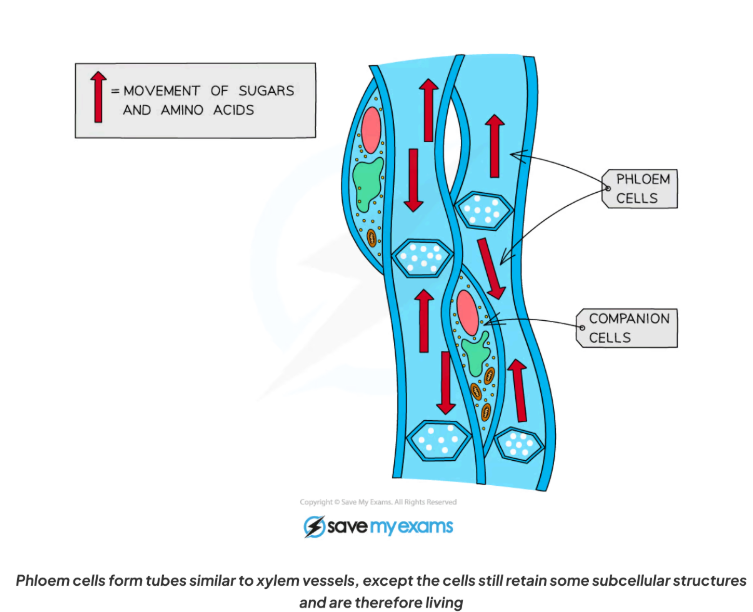Specialised Cells & Stem Cells
1/22
There's no tags or description
Looks like no tags are added yet.
Name | Mastery | Learn | Test | Matching | Spaced |
|---|
No study sessions yet.
23 Terms
Muscle
- Skeletal muscle fibres: contain myofibrils with contractile proteins.
- Specialised to shorten/contract and move bones.
-Muscle cells have a high density of mitochondria to provide sufficient energy (via respiration)form muscle contraction
All muscle cells have layers of in them,these layers can slide over each othercausing muscle contraction

Cartlidge
- Connective tissue in joints, nose, ear, trachea.
-Function= provide support
- Contains chondrocyte cells embedded in extracellular matrix.
- Collagen & elastin fibres → strong & flexible, prevents bone friction.
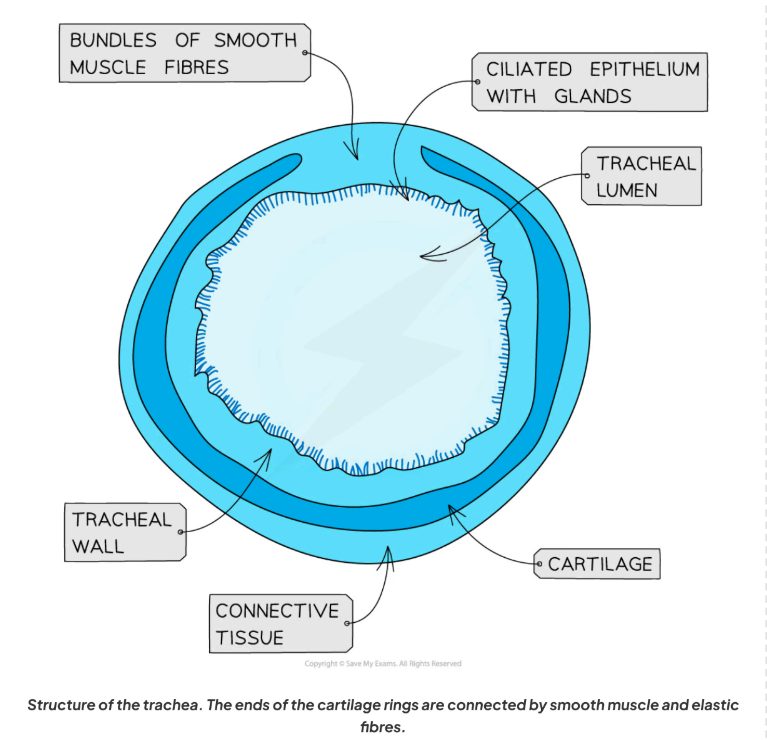
Ciliated Epithelium
- Found in trachea.
- Cilia beat rhythmically → move mucus away from lungs along epithelium tissue
- Goblet cells secrete mucus → trap bacteria/dust/microorganisms preventing infection

Squamous Epithelium
- Thin, flat cells (one cell thick).
-thin cross section shortening diffusion pathway
-permeable
-surface covering organs & structures
- Found in alveoli → rapid diffusion of oxygen into blood.

Guard Cells
- Found in pairs around stomata.
- Function: Regulate gas exchange & water loss through opening of stomata.
- Adaptations:
- Uneven cell wall thickness → open/close pore- inner walls are thicker= bend when turgid
-high density of chloroplasts & mitochondria in cytoplasm
- Control CO₂ entry for photosynthesis.
- Close in dry conditions to prevent water loss.
- Turgid → open stomata; flaccid → close stomata.
- Size: 15–20 μm
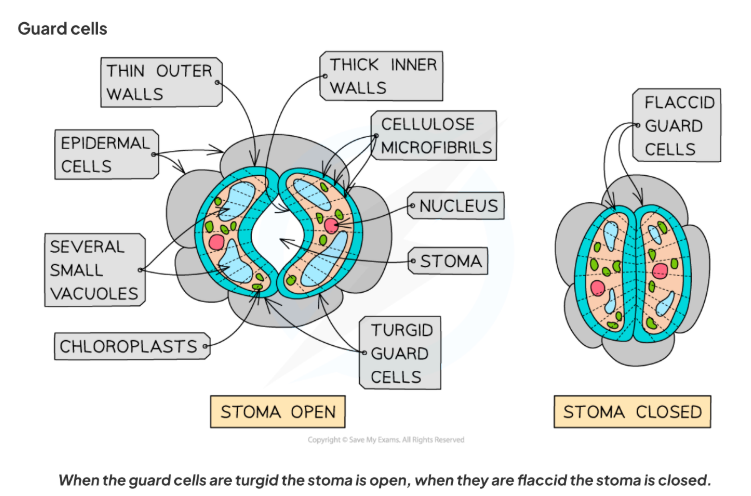
Root Hair Cells
- Found at root tips.
- Function: Absorb water & minerals.
- Adaptations:
- Long extensions (“root hairs”) → ↑ surface area.
- Thin cell wall → easy water entry an shorter diffusion distance
- Close contact with soil.
-permanent values with cell sap more concentrated than soil water maintains water potential gradient
-many mitochondria- active transport
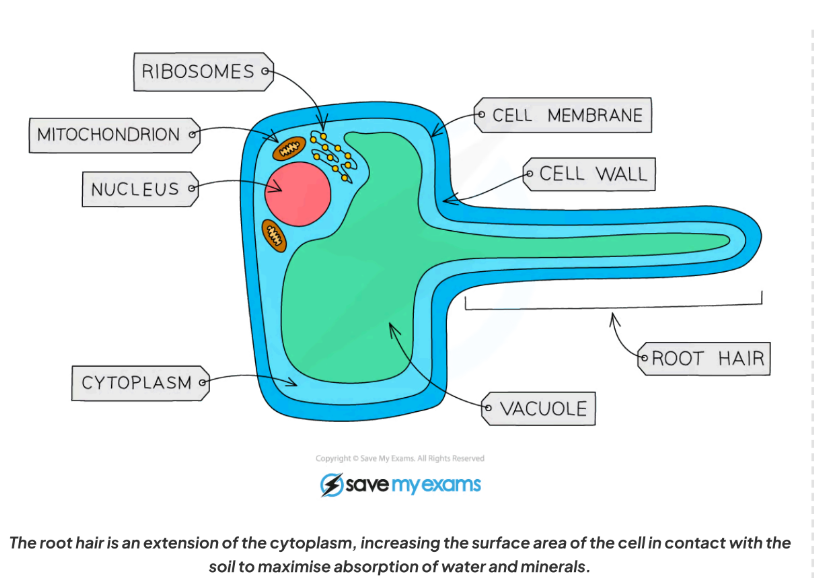
Palisade Cells
- Found in mesophyll of leaves.
- Function: Photosynthesis.
- Adaptations:
- Many chloroplasts → absorb light.
- Rectangular, closely packed → form continuous layer.
- Thin cell walls → diffusion of CO₂.
Tall and thin shape- light penetrates deeper
- Large vacuole → maintains turgor pressure.
- Chloroplasts move within cytoplasm → position optimised for light.
- Size: 25–75 μm.
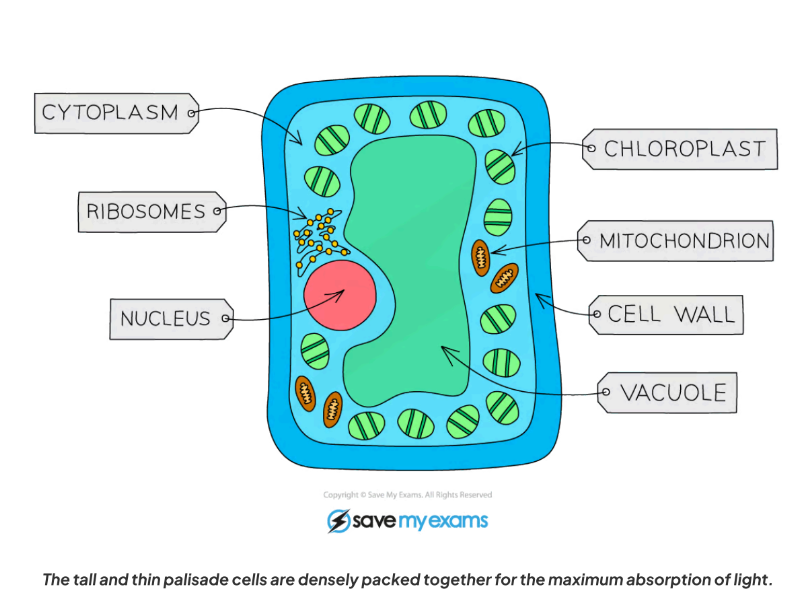
Sperm Cell
- Role: Deliver genetic information to female gamete (ovum).
- Adaptations:
- Tail/flagellum → motility (propel towards ovum) and rotates towards ovum
- Mid-piece packed with mitochondria → energy for swimming.
- Acrosome (tip of head) → digestive enzymes to penetrate ovum’s protective layers.
- Haploid nucleus → ensures correct chromosome number after fertilisation.
-Lots of mitochondria for energy
- Size: Tail ~40 μm long (not always shown in diagrams)
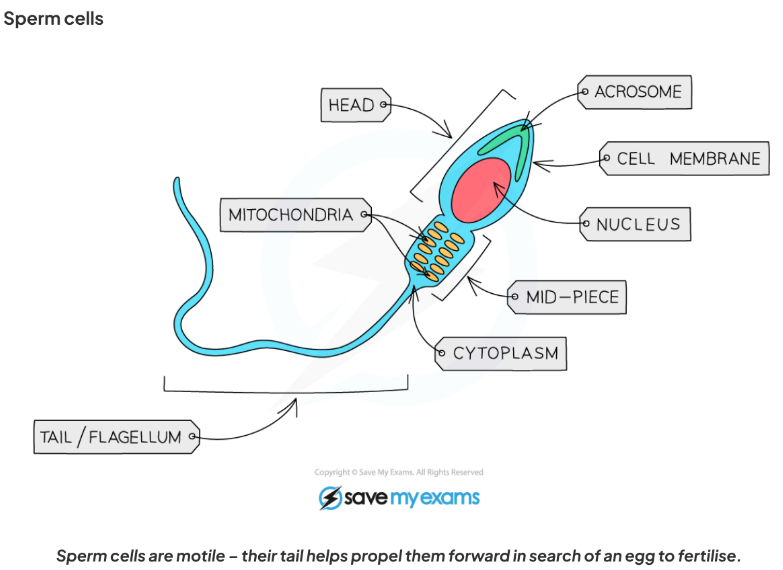
Neutrophils (Type of WBC)
- Role: Immune response- destroy pathogens by phagocytosis & secretion of enzymes.
- Adaptations:
- Multi-lobed nucleus due to flexible nuclear membrane→ squeeze through small gaps to infection sites.
- Granular cytoplasm → contains many lysosomes with digestive enzymes to destroy pathogens.
-flexibility allows them to engulf and squeeze through capillaries
-many lysozymes destroy invading cell
- Size: ~10–14 μm.
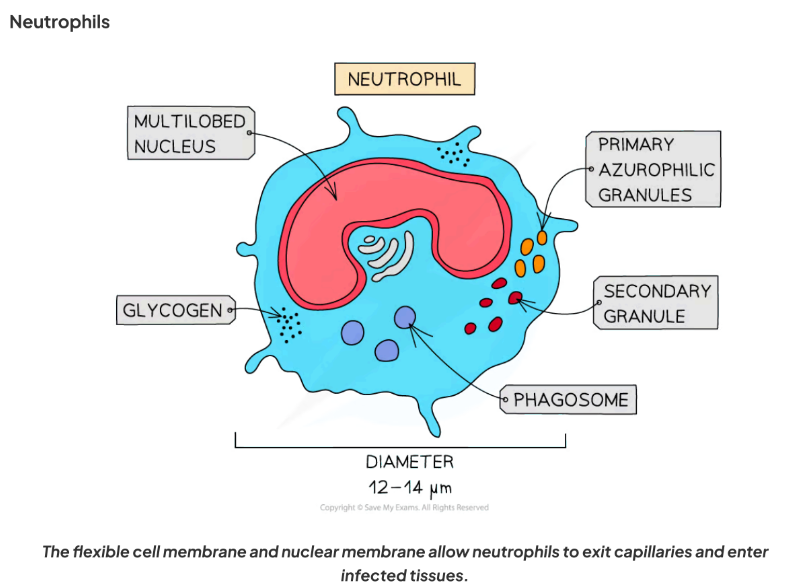
Erythrocytes (Red blood cells)
- Shape: Flattened biconcave discs → ↑ surface area: volume ratio for gas exchange.
- Function: Transport oxygen around body.
- Adaptations:
- No nucleus / few organelles → more room for haemoglobin (O₂-carrying protein).
- Flexible → squeeze through narrow capillaries.
- Packed with haemoglobin in cytoplasm.
- Size: ~7.5 μm diameter, 2 μm thick.

What are stem cells?
Stem cells = undifferentiated cells that can divide indefinitely and differentiate into specialised cell types.
Present in both plants (meristems) and animals (embryos + adults).
All stem cells share the same DNA, but express different genes depending on their role.

Totipotent
Totipotent – can differentiate into any type of cell, including extra-embryonic (zygote, first 8–16 cells after fertilisation). Can include cells in placenta (amnion) & umbilical cord (umbilicus).
Pluripotent
Pluripotent – can form all tissue types but not a whole organism (e.g., embryonic stem cells). Can’t form placenta and umbilical cord.
Can form any cell type found in an embryo.
Multipotent
Multipotent – can form a limited range of cells within a tissue type (e.g., bone marrow stem cells haematopoietic → blood cells).- adult cells
Animal Stem Cells
Embryonic stem cells
From blastocyst (5–6 days post-fertilisation).
Pluripotent.
Used in research and therapies.
Ethical issues: involves destruction of embryos.
Adult tissue stem cells
Found in bone marrow, skin, and other tissues.
Multipotent.
Replace & repair damaged cells (e.g., erythrocytes, neutrophils).
Umbilical cord stem cells also multipotent; can be stored.
Can be artificially reprogrammed → induced pluripotent stem cells (iPSCs).
Plant stem cells
Found in meristems:
Apical meristems (root/shoot tips → growth in length).
Vascular cambium (between xylem & phloem → differentiates into vascular tissue).
Cambium cells that differentiate to form the xylem lose their cytoplasm, deposit lignin in their cell
walls and lose their end cell walls
Cambium cells that differentiate to form the phloem lose some oftheir cytoplasm and organelles,
and develop sieve plates (located at ends of the cells)
Pluripotent → continue dividing throughout plant life.
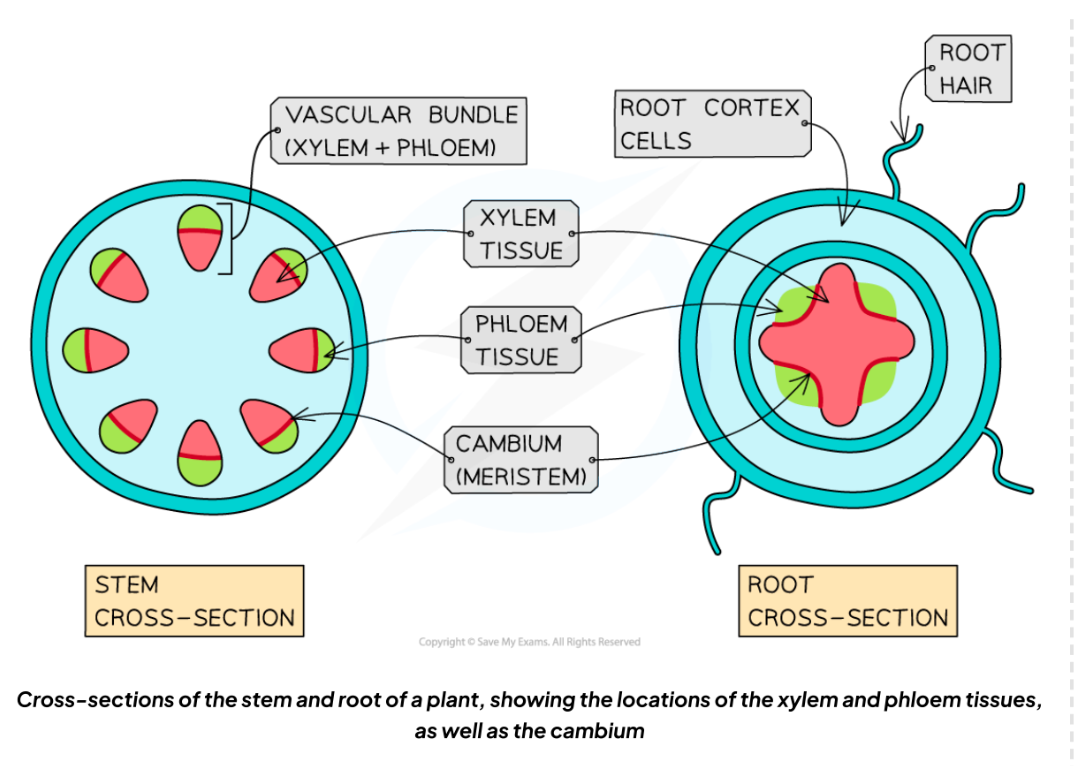
Replacement of Blood Cells
- Erythrocytes: carry O₂; short lifespan (~120 days); continuously replaced from bone marrow stem cells.
- Neutrophils: essential for immunity; lifespan ~6 hours; bone marrow must produce 1.6 billion cells/kg/hour.
🔹 Uses of Stem Cells in Medicine
Heart disease – repairing heart muscle after heart attack.
Type 1 diabetes – replacing insulin-producing pancreatic cells.
Parkinson’s disease – replacing dopamine-producing neurons.
Alzheimer’s disease – preventing neuronal loss from abnormal proteins.
Macular degeneration – treating blindness; promising results.
Birth defects – correcting defects in animal models.
Spinal injuries – restoring movement with stem cell implants.
Burns – skin grown on biodegradable meshes.
Drug testing – safer pre-clinical drug trials.
Developmental biology – studying embryo development & diseases.
🔹 Plant Stem Cells in Medicine
Many drugs are plant-derived.
Example: Paclitaxel (from yew tree bark) – used to treat breast & lung cancer.
Yew tree bark is limited and extraction expensive → stem cells provide sustainable supply.
Environmental benefit: avoids destroying rare plants.
Gene Therapy with Stem Cells
Used for SCID (Severe Combined Immunodeficiency).
Patients lack functional T cells → immune system fails.
Treatment options:
Bone marrow transplant (requires donor match; risk of rejection).
Gene therapy: patient’s stem cells removed, genetically modified to produce functioning T cells, then returned.
Risks: insertion of gene in wrong place → may trigger cancer
Ethics of Stem Cells
Embryonic stem cells: ethical objections due to destruction of embryos (seen as potential life).
Religious & moral issues: belief that life begins at conception → embryo destruction = murder.
Ownership issues: who controls embryos and genetic material?
Progress slowed by debate.
Umbilical/adult stem cells: fewer ethical issues, but limited (multipotent).
iPSCs: adult cells reprogrammed to pluripotency – reduce ethical concerns.
Plant stem cells: no ethical issues.
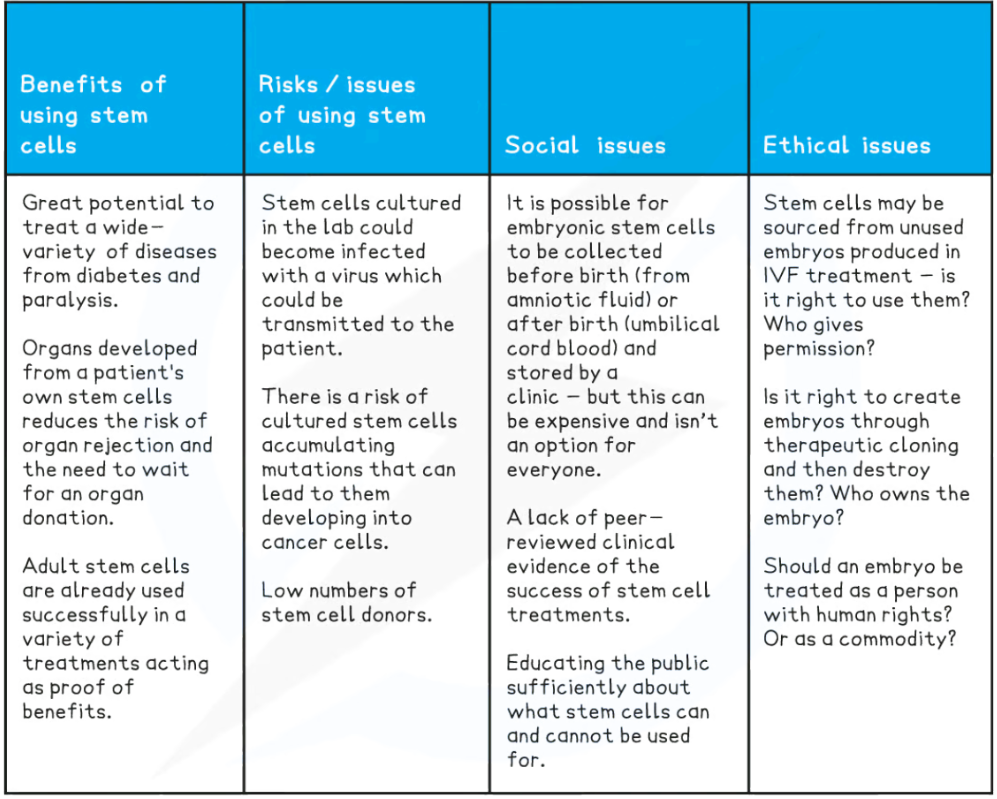
Xylem
Function: transport tissue for water and dissolved ions
Adaptations:
No top and bottom walls between cells to form continuous hollow tubes through which water is drawn upwards towards the leaves by transpiration
Cells are essentially dead, without organelles or cytoplasm to allow free movement of water
Outer walls are thickened with a substance called lignin, strengthening the tubes, which helps support the plant
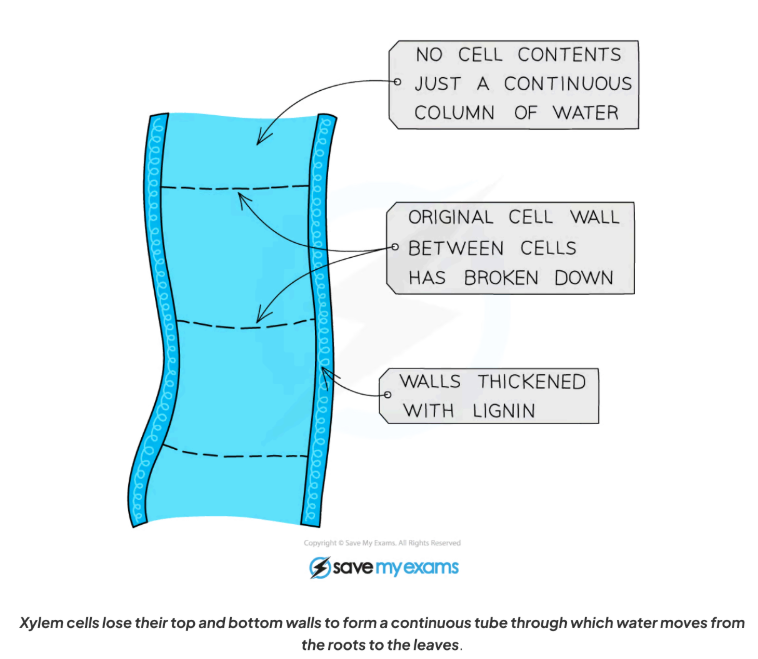
Phloem
Function:transport of dissolved sugars and amino acids
Adaptations:
Made of living cells (as opposed to xylem vessels which are made of dead cells) which are supported by companion cells that assist with loading/unloading sucrose.
Cells are joined end-to-end and contain holes in the end cell walls (sieve plates)forming tubes that allow sugars and amino acids to flow easily through (by translocation)
Cells also have very few subcellular structures to aid the flow of materials
